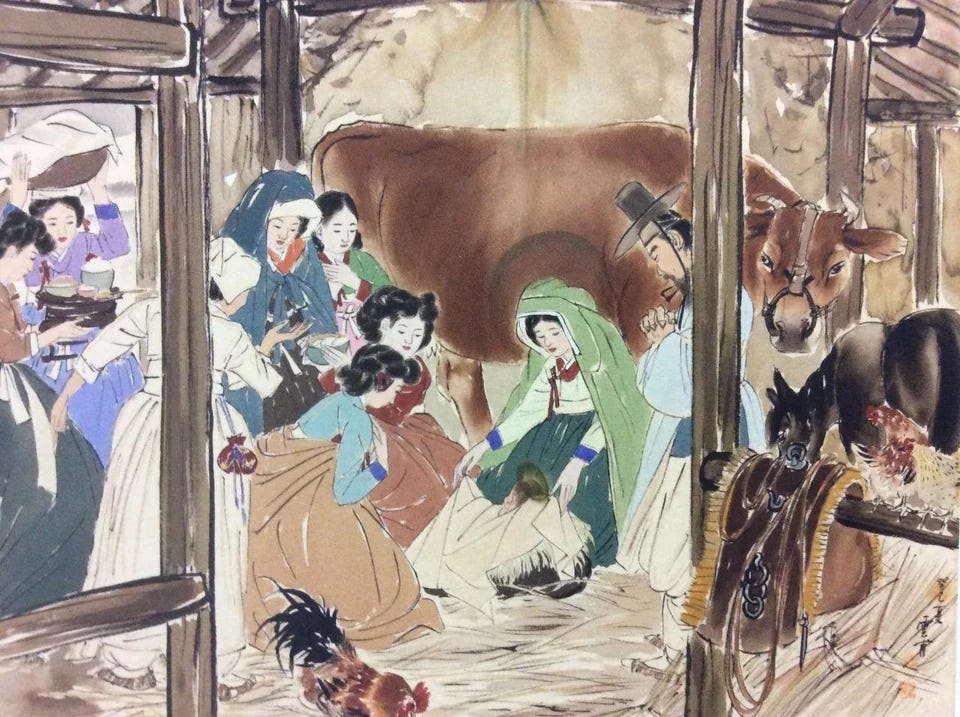Christians are mad that a Christian magazine (correctly) said Jesus was Asian
Bethlehem is, in fact, in Asia
This newsletter is free, but it’s only able to sustain itself due to the support I receive from a small percentage of regular readers. Would you please consider becoming one of those supporters? You can use the button below to subscribe to Substack or use my usual Patreon page!
There’s a bizarre “controversy” taking place in the world of evangelical Christianity and the aggressors have no clue what they’re mad about.
Just consider these two ideas:
If you believe Jesus was born in Bethlehem, then you accept that he was born in what’s now the Israeli-occupied West Bank… which is to say he’s Asian. Jesus was born in Asia.
Different cultures have often depicted Jesus in a way that’s familiar to them. That’s why you’ll see images of Black Jesus, and Ethiopian Jesus, and Indian Jesus. The “white Jesus” we typically see isn’t a matter of historical accuracy; we’re just used to Renaissance-era paintings of a light-skinned European Jesus. Those images really don’t make any sense considering the subject would have been a dark-skinned Middle Eastern Jew (nor do they match up with the description of Jesus in the Book of Revelation).
All that’s to say: If you’re discussing religious artwork from somewhere like China, you’re bound to see images of Jesus with Chinese features. There’s nothing strange about that; it happens everywhere and has been going on for centuries.

That’s what author Victoria Emily Jones focused on in a recent photo essay for Christianity Today. Jones, who blogs at Art & Theology, has spent years writing about the topic, so she was uniquely equipped to discuss “How Asian Artists Picture Jesus’ Birth From 1240 to Today.”
The artists in this photo essay bring him back to Asia—but not to ancient Israel. They make the birth a local event, translating the story into their own cultural contexts. And so we see Jesus wearing, for example, the bone necklace of an Igorot chief (the Indigenous people of northern Luzon, Philippines) or greeted by water buffalo at a roadside pavilion in Thailand.
Some may object to depicting Jesus as anything other than a brown male born into a Jewish family in Bethlehem of Judea in the first century, believing that doing so undermines his historicity. But Christian artists who tackle the subject of the Incarnation are often aiming not at historical realism but at theological meaning.
I mean… yeah, all that sounds about right. People in other parts of the world aren’t necessarily going to connect with the version of Jesus promoted by white Europeans and their descendants for all the reasons I mentioned earlier.
There are some really interesting paintings she brings up in her piece, like “The Birth of Jesus Christ” from artist Kim Ki-chang, drawn in the early 1950s:
Or consider this more recent one, Ang Kahulugan ng Pasko (The Meaning of Christmas), from Filipino artist Kristoffer Ardeña in 1995:
As Jones described it (with a Christian spin for her audience):
Whatever the motive or religious background of the artist, visual interpretations of this sacred story offer a gift of beauty to the global church.
Coupled with Asian Christian artists of the past 50 years, vibrant new imaginings of the Nativity abound. These nine artworks proclaim the expansiveness of Christ’s kingdom.
Again, none of this is controversial. If anything, I would expect Christians to celebrate the universality of their chosen myth. Look at how our story transcends cultures and geographical boundaries!
That is not, in fact, how people reacted.
Conservatives were furious at the idea that Jesus was Asian… even though that’s both literally true according to the story in the Bible and not at all the point of the entire essay. They responded with vitriol ranging from questioning the faith of the people at Christianity Today to offering the non-sensical “Jesus was Jewish!”
There was also blatant racism. Even FOX got in on the action, pretending that this was a controversy. Not surprising, I suppose, from the same network that gave us Megyn Kelly insisting Jesus was white.
The bottom line is that a bunch of morons just found out that the West Bank is in Asia and cannot believe someone writing for a Christian media outlet would have the audacity to point that out while sharing how the story of Christ is very popular in other cultures. (That’s apparently a bad thing.)
I’m not usually in the business of trying to defend a magazine that says committed gay and lesbian couples are “destructive to society” or publishes a first-person essay from a sex predator rationalizing what he did. (True story! That essay was soon updated with the lines, “I recognize that what I initially considered a consensual relationship was actually preying on a minor. Youth pastors who do the same are not ‘in relationship’ but are indeed sexual predators.” The entire article was quickly deleted after that.)
But in this case, the article was fine and made its intended point. The critics have no clue what they’re mad about because their positions on the subject are almost certainly no different from the people working at the magazine.















Believers will never acknowledge this, but the savior they are so fond of, as described in the bible, is problematic at best. Each of the four gospels describes him differently (or at least when the three synoptic gospels aren't plagiarizing each other!), and have sometimes markedly different takes on what this carpenter-turned-rabbi did. That doesn't even mention that those four stories of his life are told at minimum 40 years after his putative death, so the vagaries only increase.
And now Ms. Jones wants to assert that Jesus was Asian? About all I can come up with here is: SO WHAT? Does this mean that all Jews are originally Asian as well? Obviously, from the reaction she got, there are a LOT of upset people out there, bent out of shape because of her proposal.
What this reflects to me, more than anything else, is that not only is there no new thing under the sun for believers, THEY DON'T WANT ANYTHING NEW. They already have their Jesus defined in their head, and they want nothing to interfere with that image. Any kind of new data that contradicts their fixed image amounts to blasphemy / heresy / whatever-have-you, and they will hold their breath until they turn blue if someone suggests such a thing.
And once again, we have believers acting like spoiled children. Quelle surprise.
There is no direct evidence Jesus even existed. No contemporary historian appears to have noticed him. Not even a Jewish historian you might think would have spoken out against someone so upsetting to the status quo. We have the gospels, written down decades after the fact. There are no surviving original copies, and none of them were signed. The printing press was still fifteen hundred years in the future, and every Bible that existed was hand copied for centuries. You can't do that without mistakes creeping in. The story is not defensible without a heavy dose of special pleading and magical thinking. If Jesus existed, he certainly wasn't a blue-eyed blonde European. The Christian edifice is built of very thin stuff.